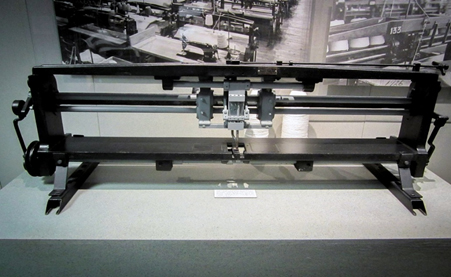Early Device That Advanced Carpet Production Cited For Historic Significance
Early Device That Advanced Carpet Production Cited For Historic Significance
Moench tufting apparatus in Georgia named a mechanical engineering landmark
NEW YORK, N.Y., Aug. 3, 2018—The device that brought mechanization and speed to fabric tufting, spurring the growth of carpet manufacturing in Georgia, was honored in a special ceremony in Dalton, Ga., on July 31, 2018.
The original Moench tufting apparatus, introduced in 1928 and featuring a durable needle that punched loops of thick fabric through a web of backing material, was named a mechanical engineering landmark by The American Society of Mechanical Engineers (ASME). Members of ASME joined with representatives of Dalton-based Shaw Industries Inc. at the designation ceremony to recognize the tufting device, which joins 265 other machine systems and products around the world that the technical society has singled out for social, economic and technological significance.
Textile innovators who followed Ernest Moench advanced the 1928 patent to bring further speed and automation to carpet production, spurring a local industry. Descendants of the Moench tufting device today produce more than 75 percent of carpets produced in the United States.
“The Moench tufting apparatus played a role in the growth of the textile industry in the State of Georgia,” said Reginald I. Vachon, a former president of ASME who spoke at the event in Dalton. “The device is a significant piece of the industrial heritage of America’s south and worthy to receive landmark status.”
About ASME
ASME helps the global engineering community develop solutions to real world challenges. Founded in 1880 as the American Society of Mechanical Engineers, ASME is a not-for-profit professional organization that enables collaboration, knowledge sharing and skill development across all engineering disciplines, while promoting the vital role of the engineer in society. ASME codes and standards, publications, conferences, continuing education and professional development programs provide a foundation for advancing technical knowledge and a safer world. www.asme.org.
ASME Media Contact:
Deborah Wetzel
Manager, Media Relations
wetzeld@asme.org
212.591.7085




